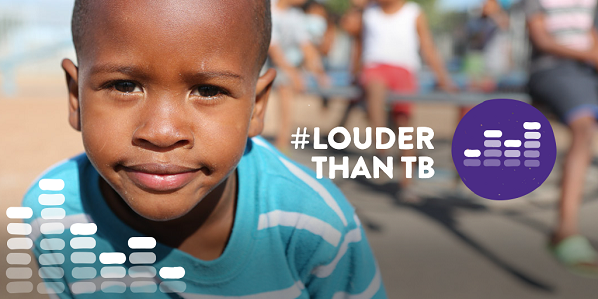World TB Day 2016: Uniting to end the childhood TB epidemic
In 2015 tuberculosis (TB) became the world’s deadliest infectious disease, currently causing the death of 1.5 million people per year. Every year around 10 million people develop TB; 1 million of them are children under the age of 14. Only 64% of these children are properly diagnosed due to lack of awareness and failing health systems. Every four minutes a child dies of TB. Approximately 10 million children are left orphaned because of TB every year.

Therefore, EDCTP – the European & Developing Countries Clinical Trials Partnership – wholeheartedly supports the ‘Louder than TB’ campaign spearheaded by the TB Alliance. The campaign aims to heighten awareness of the TB burden on children and to advocate for aligning and uniting all initiatives in order to effectively ‘End TB’ by 2035.
“These heartbreaking figures demonstrate again the severe effect of poverty-related infectious diseases on vulnerable populations. We need a united and focussed effort to, first, use the available means to improve TB control and, secondly, to fund collaborative research for prevention, safer and more efficacious treatment, and diagnostic tools. EDCTP will do its utmost to be part of such a concerted effort.”
Dr Michael Makanga, EDCTP Executive Director
On the occasion of the 46th Union meeting in Cape Town, South Africa, EDCTP already published its support for a unified response to the global problem of TB and childhood TB. The clear and immediate challenge for research is to develop better paediatric formulations and better diagnostic tools. On the occasion of World TB Day 2016, Prof. Alimuddin Zumla (Division of Infection and Immunity, University College London) – and also a Vice-Chairperson of the EDCTP Scientific Advisory Committee – and Prof. Peter D.O. Davis (University of Liverpool, United Kingdom ) summarised the recent initiatives and roadmaps to achieve the end of the TB epidemic.
They warned that global TB control may seem in reach but that we are “in reality far from achieving these bold targets.” The fight against TB will be still long and hard: a coordinated effort and unity of purpose by all parties involved is “the only way forward to achieve our ambitious targets using existing tools … whilst we wait for research and innovation to discover new and effective tools to control and prevent TB.”
TB Diagnostics: LAM TB
EDCTP invested significantly in the development of TB treatment, prevention and diagnostics. Recently, the results of the LAM TB diagnostics study, part of the EDCTP-funded TB-NEAT project led by Prof. Keertan Dheda, Cape Town University, South Africa, were published in The Lancet . The study team assessed a urine-based, lateral flow, point-of-care, lipoarabinomannan assay (LAM) and the effect of a LAM-guided strategy for the initiation of anti-tuberculosis treatment on mortality.
A pragmatic, randomised, parallel-group, multicentre trial was conducted in ten hospitals in Africa—four in South Africa, two in Tanzania, two in Zambia, and two in Zimbabwe. Eligible patients were HIV-positive adults aged at least 18 years who presented at least one of the following symptoms of tuberculosis (fever, cough, night sweats, or self-reported weight loss) while the severity of their illness necessitated admission to a hospital. The study showed that bedside LAM-guided initiation of anti-tuberculosis treatment in HIV-positive hospital inpatients with suspected tuberculosis was associated with reduced 8-week mortality.
The authors conclude that implementation of LAM testing is likely to offer the greatest benefit in hospitals where diagnostic resources are most scarce and where patients present with severe illness, advanced immunosuppression, and an inability to self-expectorate sputum.
More information
- For an overview of TB research funding by EDCTP see the World TB Day 2015 message.
- Website of the LouderThanTB campaign.
- Alimuddin Zumla and Peter D.O. Davis, ‘Progress towards achieving global tuberculosis control: so near, yet so far’, International Journal of Tuberculosis and Lung Disease 20(3): 285-286.
- Bassyouni, H.; Breugelmans, J. G.; Surette, M.; Olesen, O., ‘Childhood tuberculosis: a unified response to a global problem’, International Union Against Tuberculosis and Lung Disease, Volume 19, Supplement 1, 1 December 2015, pp. S54-S54(1).
- Jonny G Peter*, Lynn S Zijenah*, Duncan Chanda*, Petra Clowes*, Maia Lesosky, Phindile Gina, Nirja Mehta, Greg Calligaro, Carl J Lombard, Gerard Kadzirange, Tsitsi Bandason, Abidan Chansa, Namakando Liusha, Chacha Mangu, Bariki Mtafya, Henry Msila, Andrea Rachow, Michael Hoelscher, Peter Mwaba, Grant Theron, Keertan Dheda, ’Effect on mortality of point-of-care, urine-based lipoarabinomannan testing to guide tuberculosis treatment initiation in HIV-positive hospital inpatients: a pragmatic, parallel-group, multicountry, open-label, randomised controlled trial’,The Lancet Volume 387, No. 10024, p1187–1197, 19 March 2016
- Comment by Andrew D Kerkhoff, Stephen D Lawn, ‘A breakthrough urine-based diagnostic test for HIV-associated tuberculosis’, The Lancet Volume 387, No. 10024, p1139–1141, 19 March 2016.
